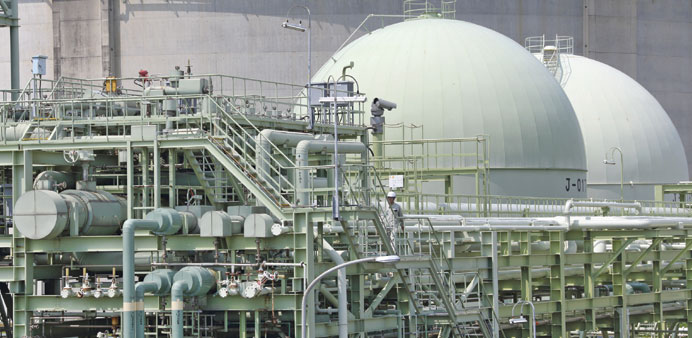A worker walks up stairs in front of liquefied natural gas tanks and gas transit lines at Osaka Gas Co.’s Senboku terminal in Japan. Asian LNG buyers will meet in New Delhi this week to discuss how to get a better deal.
Reuters
An uncomfortable prospect for global exporters of liquefied natural gas (LNG) will unfold in India this week – buyers from countries that import 70% of the world’s LNG will meet to discuss how to get a better deal.
Economic expansion, nuclear plant shutdowns in Japan and South Korea and the shift toward cleaner-burning gas in smog-choked Chinese cities have contributed to rising demand for LNG in Asia, already the top destination for the fuel.
Demand has helped push LNG prices to near record levels. Trying to find ways to cut soaring gas import bills, industry participants from India, Japan, South Korea, China and Taiwan will meet in New Delhi tomorrow to December 6, said BC Tripathi, chairman of GAIL (India), India’s biggest gas pipeline operator.
The meetings may herald the early stages of an Asian buyers’ club for natural gas in supercooled form transported on ships. Should such a grouping gain traction, a historical precedent would be the formation of the International Energy Agency, which was set up by western economies to counter Opec after the first oil shock in the 1970s.
A buyers’ group could counter the Gas Exporting Countries Forum, a loose group of 13 gas-producing nations, including Algeria, Iran, Nigeria, Oman, Qatar and Russia.
“It has been observed in some recent deals that prices offered by the same seller to Europe and Asia vary greatly, beyond net back and business considerations,” said Indian Oil Minister S. Veerappa Moily. “Large Asian buyers coming together may negotiate from a position of strength,” Moily said.
Asian importers say they are charged an excessive premium to other regions because of the tradition of linking LNG contracts to oil prices. A free market in the fuel is constrained by contractual restrictions on ship destinations.
“This is a forum exclusively for buying countries so that we collectively have a voice in the international market,” Tripathi said, speaking at another gas conference that ends today.
Tripathi said the meeting later this week was the second for buyers from the five countries that together accounted for nearly 70% of LNG shipments in 2012, according to the BP Statistical Review of World Energy.
Spot LNG prices are currently at about $18.95 per million British thermal units (mmBtu) and are closing in on last winter’s peak of $19.67, hit on February 18. They have risen over a third from this year’s low of $14.13 in May.
In the US, where surging shale gas production has pushed down prices, natural gas trades at about $3.80 per mmBtu, but the price doesn’t account for the cost of cooling the fuel to liquid form and shipping it overseas.
Most LNG is bought on long-term contract and it is the cost of these supplies that Asian buyers are trying to reduce. They also want to delink contracts from oil prices and eliminate the clauses that restrict the destination of shipments and prevent them from selling on excess cargoes.
Buyers tend to turn to the spot market as their demand fluctuates or contracted supplies are cut off due to maintenance or other outages at LNG facilities.
Asian buyers are betting on LNG shipments from the US, which has started relaxing restrictions on gas exports, to force prices down.
“Export of natural gas from America can act as a catalyst for change,” IEA head Maria van der Hoeven told the gas conference in New Delhi yesterday.
Across the region, demand for LNG is rising, while new, uncontracted sources of supply aren’t likely until at least the end of the decade. In Japan, which buys about a third of global LNG shipments, all nuclear reactors have been shut down following the Fukushima nuclear disaster of 2011. While there may be a slight decline in imports this year, they are set to rise again over the next few years as more gas-fired capacity comes online.

